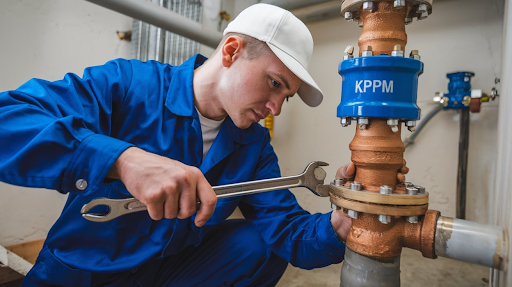KPPM water valve replacement is a crucial process for ensuring the efficiency and longevity of plumbing systems. Whether you’re a homeowner or a professional plumber, understanding how to replace KPPM water valves is essential. This guide provides all the necessary details about KPPM water valve replacement, from the tools you’ll need to step-by-step instructions to help you handle the task efficiently.
Understanding KPPM Water Valves
KPPM water valves are an integral part of any plumbing system. They control the water flow, making it easy to shut off the water supply to specific areas without disrupting the system. Over time, these valves can wear out, rust, or become faulty due to mineral deposits or wear and tear, leading to leaks or other plumbing issues. KPPM water valve replacement is necessary to avoid more severe problems.
Valves come in different types, such as ball valves, gate valves, and globe valves. It’s important to identify the type of valve before proceeding with the KPPM water valve replacement process. Understanding the mechanism of your existing valve will make it easier to find a suitable replacement.
Signs You Need a KPPM Water Valve Replacement
Before diving into the KPPM water valve replacement process, you must recognize the signs that your valve needs replacing. Common indicators include:
- Leaks around the valve.
- Difficulty turning the valve on or off.
- Rust or corrosion on the valve.
- Water flow issues, such as irregular pressure or inconsistent temperature.
Ignoring these signs could lead to water damage or inefficiencies in your plumbing system. Addressing them promptly with a KPPM water valve replacement can save you from costly repairs in the future.
Tools You’ll Need for KPPM Water Valve Replacement
Before starting the KPPM water valve replacement process, gather the necessary tools to make the job smoother. You’ll likely need the following:
- Adjustable wrench or pliers.
- Pipe cutter or hacksaw.
- Teflon tape.
- A new KPPM water valve that matches your system’s specifications.
- A bucket or towel to catch any excess water.
The right tools are essential for an efficient KPPM water valve replacement. To avoid further issues, ensure that your replacement valve is compatible with your system.
Preparing for KPPM Water Valve Replacement
Before replacing a KPPM water valve, it’s critical to take preparatory steps. First, locate your home’s main water shutoff valve and turn off the water supply. This will keep water from streaming during the substitution cycle. Once the water is off, open nearby faucets to drain any remaining water in the pipes. This step reduces pressure and minimizes potential water spillage when you remove the faulty valve.
You should also ensure the work area is clean and dry. Placing a bucket or towel underneath the valve can catch any water that might escape during the KPPM water valve replacement process.
Steps for KPPM Water Valve Replacement
- Remove the Old Valve: Begin by loosening the nuts holding the valve in place with your adjustable wrench. Applying penetrating oil can help relieve the connections if the valve is corroded. Carefully remove the old valve and inspect the surrounding pipes for damage.
- Prepare the Pipes: Once the old valve is removed, clean the pipe threads. If needed, cut the old pipes slightly to create a smooth, even surface for the new valve. Apply Teflon tape to the threads to ensure a watertight seal during your KPPM water valve replacement.
- Install the New Valve: Position the new KPPM water valve and tighten it into place using your adjustable wrench. Ensure the valve is aligned correctly with the pipes and tightly secure the connections to prevent leaks.
- Test the Valve: After securing the new valve, turn the water supply back on and check for leaks. Gradually open the valve to permit water to stream. If you notice any drips or leaks, tighten the connections until everything is secure.
Post-Replacement Inspection and Maintenance
Once your KPPM water valve replacement is complete, it’s crucial to inspect the new valve periodically to ensure it’s functioning correctly. This involves checking for leaks, ensuring smooth operation, and regularly testing water flow. Proper maintenance can extend the lifespan of your new valve and prevent the need for future replacements.
Additionally, consider scheduling routine plumbing system inspections to detect early signs of valve wear or corrosion. Addressing issues early can prevent major breakdowns and keep your system running efficiently.
Common Challenges with KPPM Water Valve Replacement
While KPPM water valve replacement is typically straightforward, you might encounter a few challenges. Stubborn or corroded valves can be complex to remove, requiring extra effort or specialized tools. Additionally, improper installation of the new valve can lead to leaks or reduced water pressure.
In some cases, the surrounding pipes may be damaged, and replacing the valve alone may not solve the issue. If you need clarification on any step in the KPPM water valve replacement process, it’s advisable to consult a professional plumber.
Benefits of Timely KPPM Water Valve Replacement
There are numerous benefits to replacing your KPPM water valves promptly. First, it helps prevent water damage caused by leaks. A faulty valve can cause extensive damage to your property if left unchecked. Timely KPPM water valve replacement also ensures that your plumbing system functions efficiently, reducing water waste and keeping your utility bills in check.
In addition, modern KPPM water valves often have improved features, such as better sealing mechanisms and more durable materials. Upgrading to a newer valve can enhance the overall performance of your plumbing system and provide long-lasting reliability.
DIY or Hire a Professional for KPPM Water Valve Replacement?
While many homeowners may choose to handle KPPM water valve replacement themselves, it’s essential to assess your skills and the complexity of the task. If the valve is in an easily accessible location and you have experience with basic plumbing, a DIY approach may be suitable. However, it might be worth hiring a professional plumber if the valve is hard to reach or the plumbing is particularly complex.
A professional will have the experience and tools to complete the KPPM water valve replacement efficiently and safely. Additionally, they can inspect your plumbing system for any other potential issues and provide expert advice on maintenance.
Conclusion: Ensuring a Successful KPPM Water Valve Replacement
KPPM water valve replacement is vital to maintaining an efficient plumbing system. Recognizing the signs that your valve needs replacement, gathering the proper tools, and following the correct steps can help you complete the process smoothly. Whether you opt for a DIY approach or hire a professional, replacing a faulty KPPM water valve promptly will save you time, money, and potential water damage in the long run.
By understanding the KPPM water valve replacement process, you can ensure your plumbing system remains in good working order, providing reliable water flow and preventing costly repairs. Proper maintenance and timely replacement of your valves are vital to keeping your home’s plumbing running efficiently for years.


